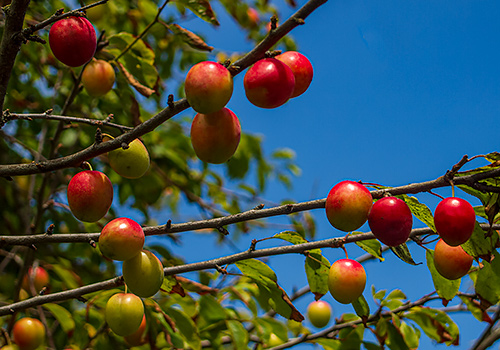Photo Corners headlinesarchivemikepasini.com
![]()
A S C R A P B O O K O F S O L U T I O N S F O R T H E P H O T O G R A P H E R
![]()
Enhancing the enjoyment of taking pictures with news that matters, features that entertain and images that delight. Published frequently.
Wild Cherries



28 June 2021
We were delighted to find these wild Rainier cherries growing along the pedestrian path that runs alongside O'Shaughnessy on the western side of Glen Canyon in San Francisco. All of a sudden, out of nowhere, cherries.

Wild Cherries. Olympus E-PL1 with 14-42mm II R kit lens at 42mm (84mm equivalent), f5.6, 1/1000 second and ISO 200. Processed in Adobe Camera Raw.
O'Shaughnessy is a main route through the city and gets a lot of traffic of all sorts. It is also a river of litter, the debris tossed from vehicles blown across the pedestrian path into the bushes along the side of the canyon.
You can find the usual empty bottles and unmentionables as well as whatever some thieves discarded during their escape along the road. Once we ran across an empty cash register drawer, in fact.
But on this occasion our gaze was upward not downward and we were rewarded by this unlikely sight.
We can die now, as the saying goes.
Yesterday we listened to an interview by Krista Tippett with Joanna Macy and Anita Barrows, who have recently translated Rainer Maria Rilke's Letters to a Young Poet written in 1903 by the German poet.
Near the end of it, Macy reflects on the perspective Rilke lends to our current dilemma. It surprisingly summed up our own impetus for photography. We'll quote it at length:
Well, it seems clear that we who are alive now are here for something and witnessing something for our planet that has not happened at any time before. And so we who are alive now and who are called to -- who feel called, those of us who feel called to love our world -- to love our world has been at the core of every faith tradition, to be grateful for it, to teach ourselves how to see beauty, how to treasure it, how to celebrate, how -- if it must disappear, if there's dying -- how to be grateful. Every funeral, every memorial service is one where you give thanks for the beauty of that life or the quality of what -- and so there's a need, some of us feel -- I know I do -- to what looks like it must disappear, to say, "Thanks, you were beautiful. Thank you, mountains. Thank you, rivers."
And we're learning, how do you say goodbye to what is sacred and holy? And that goodbye has got to be -- has got to be in deep thanksgiving for having been here, for being part of it. I kind of sound like I'm crying and I do cry, but I cry from gladness, you know. I'm so glad to recognize each other. You can look in each other's face, see how beautiful we are. It's not too late to see that. We don't want to die not knowing how beautiful this is.
It is that last line that says it all. Why we pick up a camera, why we go out into the world, why we come back with stills of a world in motion.
"We don't want to die not knowing how beautiful this is."
To see, even among the debris blowing along the side of the road, wild cherries bursting against a blue sky.